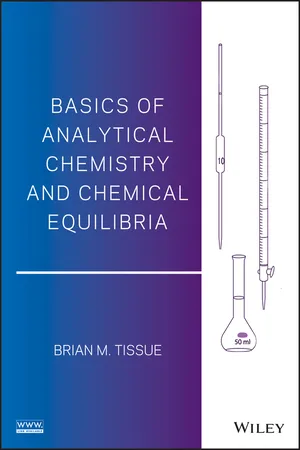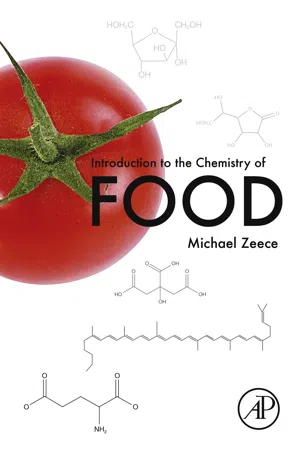Chemistry
Properties of Buffers
Buffers are solutions that resist changes in pH when an acid or base is added. They consist of a weak acid and its conjugate base, or a weak base and its conjugate acid. The key properties of buffers include their ability to maintain a relatively constant pH, their capacity to neutralize added acids or bases, and their dependence on the ratio of the weak acid and its conjugate base.
Written by Perlego with AI-assistance
Related key terms
Related key terms
1 of 4
Related key terms
1 of 3
9 Key excerpts on "Properties of Buffers"
- eBook - ePub
- Professor Rob Beynon, J Easterby(Authors)
- 2004(Publication Date)
- Taylor & Francis(Publisher)
Chapter 2 , but these need not concern us here.◊ Nearly all pH buffers are weak acids or bases.Notice that the weak acid can be neutral (acetic acid) or carry a positive (TrisH+ ) or negative (phosphate1– ) charge. As we develop the theory of buffers, it will become clear that these charges on the buffer species have important consequences.2. Weak acids and bases resist pH changesA buffer is able to resist changes in pH because it exists in an equilibrium between a form that has a hydrogen ion bound (conjugate acid, protonated) and a form that has lost its hydrogen ion (conjugate base, deprotonated). For the simple example of acetic acid, the equation is:CH 3COOH ⇌CH 3COO −+H +Here, the protonated form is acetic acid, with a net charge of zero, whereas the deprotonated form (acetate) has a charge of −1. The two species are in equilibrium, and this equilibrium, in common with all equilibria, can be displaced by addition of one component.Consider a solution that contains equal amounts of acetic acid and acetate ions (10 mM acetic acid, 10 mM sodium acetate, for example). If we were to add a strong acid, such as HCl, to this solution, the added H+ would displace the equilibrium to the left. Binding of H+ to CH3 COO– ‘mops up’ the added protons (Figure 3.1 ). Electrical neutrality is preserved because every H+ that reacts with a CH3 COO– anion to form the neutral CH3 COOH leaves behind a chloride (Cl– ) anion in its place. Add a strong base, such as sodium hydroxide, and the OH- ion would react with the H+ and displace the equilibrium to the right. Electrical neutrality in the solution is sustained because for every CH3 COOH that is converted to CH3 COO– , a corresponding Na+ - No longer available |Learn more
- Steven Boone, Drew H. Wolfe(Authors)
- 2011(Publication Date)
- Collins Reference(Publisher)
CHAPTER 17Aqueous Equilibria: Buffers, Titrations, Solubility, and Complex Ion Equilibria
I n this chapter, our discussion of acids and bases continues by considering buffer solutions, those that resist changes in the pH, and titrations, volumetric procedures in which unknown acid or base solutions are neutralized with known base or acid solutions. Additionally, solubility and complex ion equilibria will be discussed. A solubility equilibrium establishes between undissolved solutes and their dissolved ions. Complex ion equilibria establish between coordination complexes and their ions.17.1 BUFFER SOLUTIONSSolutions that contain both an acid and its conjugate base, or a base and its conjugate acid in sufficient quantity are called buffer solutions. The Nature of Buffer Solutions Buffer solutions maintain a nearly constant pH despite the addition of small amounts of either acids or bases. In other words, buffer solutions resist changes in pH. Components of a Buffer SolutionIf an acid is added to a buffer solution, it must have a basic component to neutralize the acid, and if a base is added to a buffer solution, it must have an acidic component to neutralize the base. Hence, buffer solutions are prepared by mixing either a weak acid and its conjugate base, or a weak base and its conjugate acid.Buffering Action: Adding Acid to a Buffer SolutionTo understand how buffer solutions maintain a constant pH, let’s consider a buffer prepared by mixing equimolar amounts of the weak acid acetic acid, HC2 H3 O2 , and the sodium salt of its conjugate base, sodium acetate, NaC2 H3 O2 . The net ionic equation for the equilibrium that establishes in this buffer solution is as follows.The Na+ ion from the sodium acetate is present as a spectator ion. If a small amount of a strong acid such as HC1 is added to this buffer solution, the resulting H+ ions shift the equilibrium to the left. The net result of adding the HC1(aq) is to decrease the acetate ion concentration and increase the acetic acid concentration. Almost all the added H+ - No longer available |Learn more
- Brian M. Tissue(Author)
- 2013(Publication Date)
- Wiley(Publisher)
Chapter 6: Buffer Solutions and Polyprotic Acids
Learning Outcomes- Identify buffer solutions and predict p[ ] using the Henderson–Hasselbalch equation.
- Use alpha fraction plots to predict the dominant form of a weak acid as a function of pH.
- Describe the regions of a weak acid titration curve and calculate analyte concentration.
- Identify polyprotic acids and determine the limiting reagent in neutralization reactions.
- Predict p[ ] for different forms of a polyprotic weak acid.
6.1 Buffer Solutions
A buffer in chemistry is anything that counteracts a change to a chemical system. A buffer will be added to a test portion to control one or more aspects of the solution chemistry that might affect a measurement. In redox chemistry, a “redox buffer” can maintain one or more species in a certain oxidation state. Analytical methods for iron will often use a reducing agent, for example, hydroxylamine in the Fe-phenanthroline practice exercise in Chapter 4, as a reagent to retain the iron in the Fe form. A pH buffer is a solution that can maintain a nearly constant pH when diluted or when a small amount of strong acid or strong base is added. A buffer solution consists of a mixture of a weak acid and its conjugate base. Describing a buffer as a weak base and its conjugate acid is equivalent. As many analytes and reagents have acidic or basic groups, acid–base buffers are common in analytical applications to control the solution chemistry. You will see from the examples in the chapter that buffer systems also exist in many environmental and biological systems.How can we make a pH buffer? There are several ways to produce a mixture of a weak acid and its conjugate base:- Mix a weak acid and a salt of its conjugate base in solution.
- Mix a weak acid and enough strong base to neutralize some of the weak acid.
- Mix a weak base and enough strong acid to neutralize some of the weak base.
Any of these procedures will result in a solution that contains a weak acid and its conjugate base. The last two cases are limiting reagent calculations, with the strong base or strong acid being the limiting reagent. Adding excess strong base to a weak acid, or excess strong acid to a weak base, will not produce buffer solutions. The pH response of a buffer solution is illustrated in the following examples. - eBook - ePub
- Peter Kam, Ian Power(Authors)
- 2015(Publication Date)
- CRC Press(Publisher)
K) of the substance.P H SYSTEMH+ ion concentration may be measured in two ways: directly as concentrations in nanomoles per litre or indirectly as pH. pH is defined as the negative logarithm (to the base 10) of the concentration of hydrogen ions. The pH is related to the concentration of H+ as follows:pH = log101[H +]pH = log10[H +]H +=10− pHpH = p K + log base/acidTable 8.1 Relationship between pH and hydrogen ion concentrationpH Hydrogen ion concentration (nmol/L) 7.7 20 7.4 40 7.3 50 7.1 80 It is important to note that pH and hydrogen ion concentration [H+ ] are inversely related such that an increase in pH describes a decrease in [H+ ] (Table 8.1 ). However, the logarithmic scale is nonlinear and, therefore, a change of one pH unit reflects a 10-fold change in [H+ ] and equal changes in pH are not correlated with equal changes in [H+ ]. For example, a change of pH from 7.4 to 7.0 (40 nmol/L [H+ ] to 100 nmol/L [H+ ]) represents a change of 60 nmol/L [H+ ], although the same pH change of 0.4, but from 7.4 to 7.8 (40 nmol/L [H+ ] to 16 nmol/L [H+ ]), represents a change of only 24 nmol/L [H+ ].BUFFERSA buffer is a solution consisting of a weak acid and its conjugate base, which resists a change in pH when a stronger acid or base is added, thereby minimizing a change in pH. The most important buffer pair in extracellular fluid (ECF) is carbonic acid (H2 CO3 ) and bicarbonate (HYDROGEN ION BALANCEHCO 3 −). The interaction between this buffer pair forms the basis of the measurement of acid–base balance.Cellular hydrogen ion turnover can be described in terms of processes that produce or consume H+ ions in the body (Table 8.2 ). The total daily H+ - eBook - ePub
- Linda Costanzo(Author)
- 2021(Publication Date)
- Elsevier(Publisher)
− form.The body fluids contain a large variety of buffers, which constitute an important first defense against changes in pH. Robert Pitts demonstrated this buffering capacity experimentally by injecting 150 mEq of H+ (as hydrochloric acid, HCl) into a dog whose total body water was 11.4 L. In a parallel experiment, Pitts added 150 mEq of H+ to 11.4 L of distilled water. In the dog, the addition of H+ caused the blood pH to decrease from 7.44 to 7.14—the dog was acidemic but alive. In the distilled water, addition of the same amount of H+ caused the pH to drop precipitously to 1.84, a value that would have been instantly fatal to the dog. Pitts concluded that the dog’s body fluids contained buffers that protected its pH from the addition of large amounts of H+ . The added H+ combined with the A− form of these buffers, and a strong acid was converted to a weak acid. The decrease in the dog’s body fluid pH was minimized, although not totally prevented. The distilled water contained no buffers and had no such protective mechanisms.Henderson-Hasselbalch equation
The Henderson-Hasselbalch equation is used to calculate the pH of a buffered solution. This equation is derived from the behavior of weak acids (and bases) in solution, which is described by the kinetics of reversible reactions:HA⇄K 2K 1H ++A −The forward reaction, the dissociation of HA into H+ and A− , is characterized by a rate constant, K1 , and the reverse reaction is characterized by a rate constant, K2 . When the rates of the forward and reverse reactions are exactly equal, there is a state of chemical equilibrium, in which there is no further net change in the concentration of HA or A− . As shown here, the law of mass action - eBook - ePub
- Michael Zeece(Author)
- 2020(Publication Date)
- Academic Press(Publisher)
M acetic acid solution has a pH of about 2.9. At pH 2.9 there is an equilibrium between the acid and its dissociation to hydronium and acetate ions.COOH +CH3Acetic AcidH 2O ⇄waterCH3+COO−Acetate ionH3O +Hydronium ionWhen a small amount of acid (H 3O +) is added to this solution, a proton is added to the acetate ion (CH3COO−) causing a shift in the equilibrium and a slight decrease in pH. Continuing to add acid will result in a decrease of pH until all the acetate has been neutralized. At that point, the buffering effect ends and pH of the solution declines sharply.CH3+COO−H 3O +⇄COOH +CH3H 2OConversely, when a small amount of base (OH−) is added to the solution, a proton is taken from acetic acid (COOHCH3) causing a shift in the equilibrium and increase the pH. Continuing to add base results in an increase of pH until all the acetic acid has been neutralized. At that point, the buffering effect ends and pH of the solution increases sharply.Without a buffer, small additions of acid or base cause a large decrease, or increase, respectively, in pH.COOH +CH3⇄OH−CH3+COO−H 2OHenderson-Hasselbalch equation
Weak acids and bases play important roles in the chemistry of food and life. Since these molecules only partially dissociate in water, their strength as an acid or base varies considerably. As stated above, pKa is a measure of an acid's ability to ionize and pH is a direct measure of acidity (i.e., hydronium ion concentration). The relationship between pH and pKa can be combined in an useful expression known as the Henderson-Hasselbalch equation. For example, this equation can be used to illustrate the buffering effect of weak acids and bases. Briefly, the equation states that pH of a weak acid is equal to its pKa plus the log of ratio between the basic and acidic forms. - No longer available |Learn more
MCAT General Chemistry Review 2024-2025
Online + Book
- (Author)
- 2023(Publication Date)
- Kaplan Test Prep(Publisher)
endpoint of a titration is when the indicator reaches its final color.- Multiple buffering regions and equivalence points are observed in polyvalent acid and base titrations.
- Buffer solutions consist of a mixture of a weak acid and its conjugate salt or a weak base and its conjugate salt; they resist large fluctuations in pH.
- Buffering capacity refers to the ability of a buffer to resist changes in pH; maximal buffering capacity is seen within 1 pH point of the pKa of the acid in the buffer solution.
- The Henderson–Hasselbalch equation quantifies the relationship between pH and pKa for weak acids and between pOH and pKb for weak bases; when a solution is optimally buffered, pH = pKa and pOH = pKb .
ANSWERS TO CONCEPT CHECKS
10.1
-
DefinitionAcidBase
Arrhenius Dissociates to form excess H+ in solution Dissociates to form excess OH− in solution Brønsted–Lowry H+ donor H+ acceptor Lewis Electron pair acceptor Electron pair donor -
AnionAcid FormulaAcid Name
MnO4 − HMnO4 Permanganic acid Titanate (TiO3 2− ) H2 TiO3 Titanic acid I− HI Hydroiodic acid IO4 − HIO4 Periodic acid -
ReactionAmphoteric ReactantAmphiprotic? (Y or N)
HCO3 − + HBr → H2 CO3 + Br− HCO3 − Yes 3 HCl + Al(OH)3 → AlCl3 + 3 H2 O Al(OH)3 No 2 HBr + ZnO → ZnBr2 + H2 O ZnO No
10.2
- An amphoteric species can act as an acid or a base.
- High Ka indicates a strong acid, which will dissociate completely in solution. Having a Ka slightly greater than water means the acid is a weak acid with minimal dissociation.
- High Kb indicates a strong base, which will dissociate completely in solution. Having a Kb
- eBook - ePub
- Gillian Cockerill, Stephen Reed(Authors)
- 2011(Publication Date)
- Wiley(Publisher)
+ ] because log 1/2 = −0.3.Two useful ‘rules of thumb’ approximationsBuffers1. For every 0.01 pH unit change from 7.00, the [H+ ] changes by 1 nmol/L. This ‘rule’ applies most reliably in the range of pH values 7.20 to 7.60.2. For every 0.1 unit increase in pH from 7.00, multiply the previous [H+ ] by 0.8 – ‘the 80% (or 0.8) approximation’. For example:The pH of the body fluid compartments is very carefully regulated, as changes can have an impact on the normal metabolic activities of a cell. Without appropriate homeostatic buffering mechanisms, the protons produced by metabolism would make survival impossible. Physiologically important buffers consist of a conjugate weak acid and its corresponding base anion. The relative concentrations of the components of a buffer system at a given pH are defined by the Henderson-Hasselbalch equation:We can predict from the Henderson-Hasselbalch equation that buffers are most efficient in ‘mopping-up’ free protons when there are approximately equal proportions of base and acid present, i.e. 1:1 acid: base ratio and pH = pKa . In practice, in a test-tube, buffer efficiency is maximal when the actual pH = pKa ± 1 pH unit. Some in vivo buffer systems, notably the carbonic acid/bicarbonate couple, work effectively outside the range of pKa ± 1 pH unit because we are able, through normal physiological mechanisms, to maintain the correct base:acid ratio.As we shall see in more detail later, the principal buffers in body fluids are proteins and bicarbonate/carbonic acid in blood, bicarbonate/ carbonic acid in ISF, proteins and phosphate in ICF, and phosphate and ammonia in urine.Passage contains an image SECTION 3.ii Some worked example calculations
i. - Stig Pedersen-Bjergaard, Bente Gammelgaard, Trine G. Halvorsen(Authors)
- 2019(Publication Date)
- Wiley(Publisher)
3 Fundamentals of Bases, Acids, Solubility, Polarity, Partition, and Stereochemistry 3.1 Acids, Bases, pH, and p K a 3.2 Buffers 3.3 Acid and Base Properties of Drug Substances 3.4 Distribution Between Phases 3.5 Stereoisomers 3.6 Active Pharmaceutical Ingredients – A Few Examples 3.6.1 Fluoxetine – A Basic and Lipophilic Drug 3.6.2 Atenolol – A More Polar Basic Drug 3.6.3 Morphine – A Zwitterionic Drug (Base and Acid) 3.6.4 Ibuprofen – An Acidic Drug 3.6.5 Paracetamol – A Weak Acid 3.6.6 Hydrocortisone – A Neutral Drug 3.7 Stability of Drug Substances 3.1 Acids, Bases, pH, and p K a Water can react with itself to form hydronium ions (H 3 O +) (also called hydroxonium ions) and hydroxide ions (OH −): (3.1) This is termed autoprotolysis and water acts as an acid (donating a proton, H +) as well as a base (accepting a proton). The autoprotolysis constant K w (equilibrium constant) is (3.2) As seen from Eq. (3.2) only a very small amount of water is ionized. The concentration of hydronium ions, [H 3 O + ], and hydroxide ions, [OH − ], in pure water is therefore 10 −7 M. [H 3 O + ] is equivalent to [H + ] and both terms will be used in the following. The pH value of an aqueous solution is defined as the negative logarithm to the activity (a H +), and the latter is approximated to the concentration of protons ([H + ]): (3.3) Aqueous solutions with pH < 7 are acidic. If pH = 7, the solution is neutral, and if pH > 7 the solution is alkaline. An aqueous solution with pH 1 is strongly acidic, whereas a solution with pH 5 is slightly acidic. Similarly, at pH 13 solutions are strongly alkaline and at pH 9 solutions are slightly alkaline. Strong acids, such as HCl, are fully dissociated and ionized in dilute aqueous solution. Hydrochloric acid (HCl) dissociates completely according to the following reaction when dissolved in water: (3.4) High concentrations of strong acids dissolved in water provide a strongly acidic solution
Index pages curate the most relevant extracts from our library of academic textbooks. They’ve been created using an in-house natural language model (NLM), each adding context and meaning to key research topics.
Explore more topic indexes
Explore more topic indexes
1 of 6
Explore more topic indexes
1 of 4








